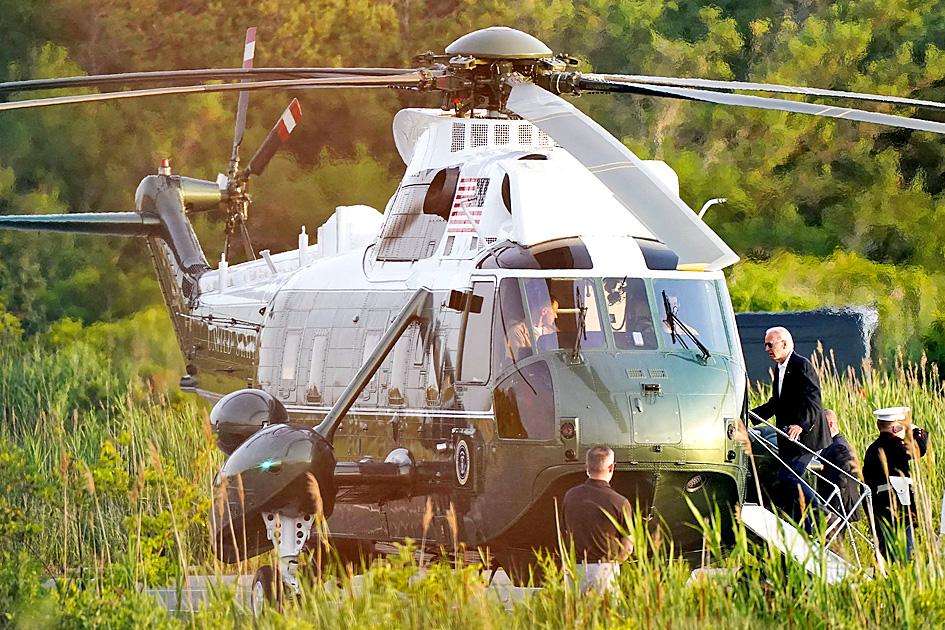Both houses of the US Congress have made progress on their respective drafts of an annual defense policy bill — the National Defense Authorization Act (NDAA) — that includes provisions to strengthen defense-related engagement with Taiwan.
In the US Senate, the Armed Services Committee on Thursday said that it had passed a draft version of the NDAA for fiscal year 2023 in a bipartisan 23-3 vote and had sent it to the full Senate for consideration.
A summary released by the committee said that the draft bill would require engagement with Taiwanese officials to develop and implement a multi-year plan for the acquisition of appropriate defensive capabilities.

Photo: Reuters
The bill would also mandate engagement with Taiwan on a series of combined training, exercises and planning activities, the committee said.
The US’ policy would be to maintain its armed forces “to deny a fait accompli against Taiwan,” to deter China from using military force to unilaterally change the “status quo” with Taiwan, the committee said in the summary.
The draft Senate bill calls for US$857.6 billion of defense spending, an increase of US$44 billion over the US$813.3 billion requested by US President Joe Biden.
That is an increase of US$87 billion from last year’s defense budget.
Meanwhile, the US House of Representatives’ Armed Services Committee on Monday released the full text of its draft version of the NDAA, which is still in the committee’s markup process and is to be reviewed today.
In its current form, the House’s draft bill largely hews to the final version of the NDAA that was signed into law last year, with the exception of an expanded “sense of Congress” section on US-Taiwan defense relations.
While last year’s version of the NDAA committed to supporting Taiwan’s acquisition of defense articles with an emphasis on asymmetric capabilities, this year’s draft specifies that this might include “anti-ship, coastal defense, anti-armor, air defense [and] undersea warfare” capabilities.
The section also contains a new phrase that says the US should be “committed to the defense of a free and open society in the face of aggressive efforts by [China] to curtail or influence the free exercise of rights or democratic franchise.”
The House draft would authorize a lower amount of US$802.4 billion of defense spending.
Typically, both houses of Congress pass their own versions of the NDAA and negotiate a reconciliation of the bill to be signed into law — a process that last year was not completed until December.

Taiwan is projected to lose a working-age population of about 6.67 million people in two waves of retirement in the coming years, as the nation confronts accelerating demographic decline and a shortage of younger workers to take their place, the Ministry of the Interior said. Taiwan experienced its largest baby boom between 1958 and 1966, when the population grew by 3.78 million, followed by a second surge of 2.89 million between 1976 and 1982, ministry data showed. In 2023, the first of those baby boom generations — those born in the late 1950s and early 1960s — began to enter retirement, triggering

ECONOMIC BOOST: Should the more than 23 million people eligible for the NT$10,000 handouts spend them the same way as in 2023, GDP could rise 0.5 percent, an official said Universal cash handouts of NT$10,000 (US$330) are to be disbursed late next month at the earliest — including to permanent residents and foreign residents married to Taiwanese — pending legislative approval, the Ministry of Finance said yesterday. The Executive Yuan yesterday approved the Special Act for Strengthening Economic, Social and National Security Resilience in Response to International Circumstances (因應國際情勢強化經濟社會及民生國安韌性特別條例). The NT$550 billion special budget includes NT$236 billion for the cash handouts, plus an additional NT$20 billion set aside as reserve funds, expected to be used to support industries. Handouts might begin one month after the bill is promulgated and would be completed within

The National Development Council (NDC) yesterday unveiled details of new regulations that ease restrictions on foreigners working or living in Taiwan, as part of a bid to attract skilled workers from abroad. The regulations, which could go into effect in the first quarter of next year, stem from amendments to the Act for the Recruitment and Employment of Foreign Professionals (外國專業人才延攬及僱用法) passed by lawmakers on Aug. 29. Students categorized as “overseas compatriots” would be allowed to stay and work in Taiwan in the two years after their graduation without obtaining additional permits, doing away with the evaluation process that is currently required,

IMPORTANT BACKER: China seeks to expel US influence from the Indo-Pacific region and supplant Washington as the global leader, MAC Minister Chiu Chui-cheng said China is preparing for war to seize Taiwan, Mainland Affairs Council (MAC) Minister Chiu Chui-cheng (邱垂正) said in Washington on Friday, warning that Taiwan’s fall would trigger a regional “domino effect” endangering US security. In a speech titled “Maintaining the Peaceful and Stable Status Quo Across the Taiwan Strait is in Line with the Shared Interests of Taiwan and the United States,” Chiu said Taiwan’s strategic importance is “closely tied” to US interests. Geopolitically, Taiwan sits in a “core position” in the first island chain — an arc stretching from Japan, through Taiwan and the Philippines, to Borneo, which is shared by